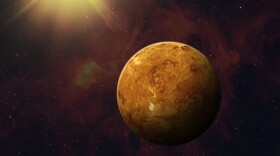-
Strange Universe With Bob BermanWednesday August 13 around 5:15–5:30 a.m., early risers with a clear view of the eastern horizon can witness a rare celestial lineup: the crescent Moon alongside Venus—the dazzling Morning Star—with Jupiter shining above and Mercury low near the horizon. This nearly vertical arrangement of the three brightest night sky objects, plus elusive Mercury, happens only in late summer and early fall when the solar system’s plane aligns upright at dawn—making it well worth setting an early alarm.
-
Strange Universe With Bob BermanSet your alarm early this week and look east between 5:00 and 5:30 a.m. to catch a stunning celestial display. Brilliant Venus, the Morning Star, shines high with the bright orange star Aldebaran glowing below. Aldebaran, part of the V-shaped Hyades cluster in Taurus, has a rich astronomical legacy—its position once helped confirm Einstein’s theory of General Relativity. Nearby, you’ll also spot the shimmering Pleiades cluster. Together, these stars create a breathtaking, layered view of the cosmos worth waking up for.
-
Strange Universe With Bob BermanSo far this cold season, Earth's sister planet has heated up the evening sky like a UFO. You've surely seen that dazzling "star" soon after sunset: This has been its best showing since 2017. That eight-year interval is no accident. So happens, 13 of Venus’ years around the Sun have the same number of days as eight Earth years. They both work out to 2,922 days. Tune in to hear when you can see expect these special evenings.
-
Strange Universe With Bob BermanWhat’s the weather typically like in February? We’ll also explore the history of the famous woodchuck, and what science actually backs Groundhog Day.
-
Strange Universe With Bob BermanVenus is now starting an extraordinary cycle. Also called the evening star, it’s not the least bit hard to find. It will spend the next nine months in the west after sunset, slowly growing higher and brighter.
-
Strange Universe With Bob BermanTune in to hear about when a predawn conjunction will take place, and hear about all the wild features of our closest planet, Venus.
-
Strange Universe With Bob BermanJupiter gets its closest to earth in 2023. The giant planet at one point will be the nearest object to the moon! Hear about the mass of Jupiter and its system of moons.
-
Strange Universe With Bob BermanThis week we’ll learn about Venus’ ferocious winds, just how slow the planet spins, and how the carbon dioxide bubbling planet could perfectly line up with the Sun.
-
Venus is now at its very brightest, at magnitude -4.7, which makes beginners wonder what that means. If Venus is the most brilliant starlike object, what can we compare it with? Well, summer’s brightest stars are magnitude zero and one, which makes them 100 times less luminous than Venus. The magnitude business started with an ancient Greek named Hipparchus, who assigned each star a different magnitude. Hear the buildup to using photometers and what how certain starts became visible with time.
-
Venus is now at its very brightest, at magnitude -4.7, which makes beginners wonder what that means. If Venus is the most brilliant starlike object, what can we compare it with? Well, summer’s brightest stars are magnitude zero and one, which makes them 100 times less luminous than Venus. The magnitude business started with an ancient Greek named Hipparchus, who assigned each star a different magnitude. Hear the buildup to using photometers and what how certain starts became visible with time.

Play Live Radio
Next Up:
0:00
0:00
Available On Air Stations










